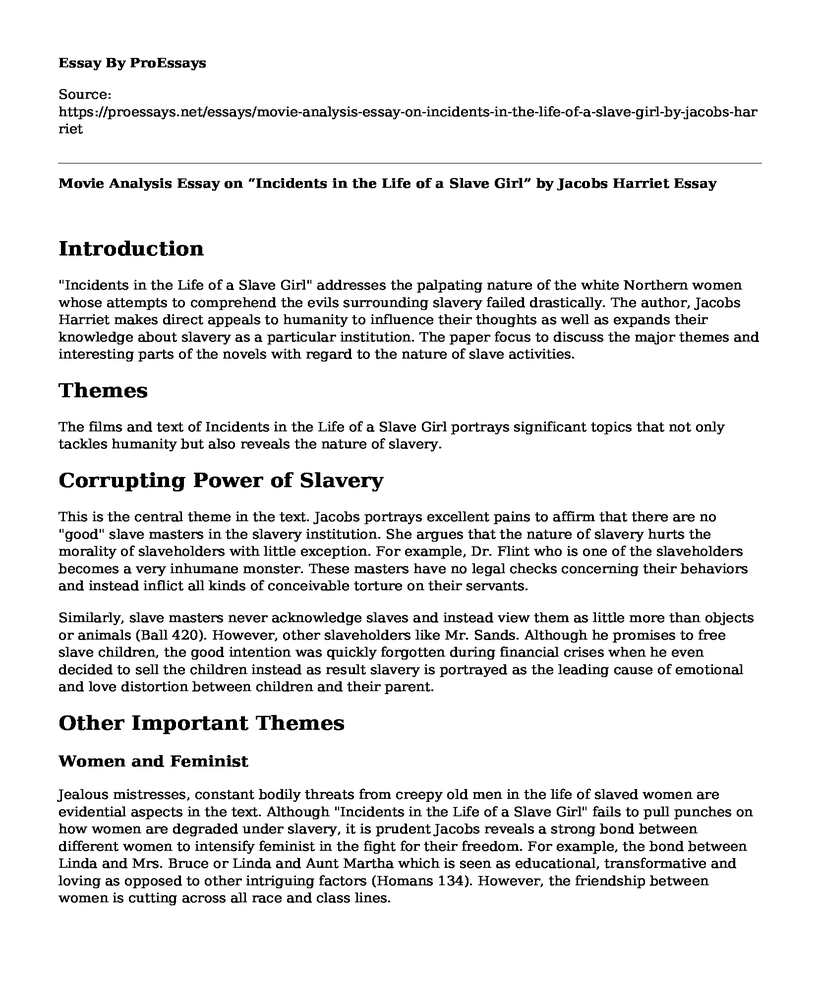Introduction
"Incidents in the Life of a Slave Girl" addresses the palpating nature of the white Northern women whose attempts to comprehend the evils surrounding slavery failed drastically. The author, Jacobs Harriet makes direct appeals to humanity to influence their thoughts as well as expands their knowledge about slavery as a particular institution. The paper focus to discuss the major themes and interesting parts of the novels with regard to the nature of slave activities.
Themes
The films and text of Incidents in the Life of a Slave Girl portrays significant topics that not only tackles humanity but also reveals the nature of slavery.
Corrupting Power of Slavery
This is the central theme in the text. Jacobs portrays excellent pains to affirm that there are no "good" slave masters in the slavery institution. She argues that the nature of slavery hurts the morality of slaveholders with little exception. For example, Dr. Flint who is one of the slaveholders becomes a very inhumane monster. These masters have no legal checks concerning their behaviors and instead inflict all kinds of conceivable torture on their servants.
Similarly, slave masters never acknowledge slaves and instead view them as little more than objects or animals (Ball 420). However, other slaveholders like Mr. Sands. Although he promises to free slave children, the good intention was quickly forgotten during financial crises when he even decided to sell the children instead as result slavery is portrayed as the leading cause of emotional and love distortion between children and their parent.
Other Important Themes
Women and Feminist
Jealous mistresses, constant bodily threats from creepy old men in the life of slaved women are evidential aspects in the text. Although "Incidents in the Life of a Slave Girl" fails to pull punches on how women are degraded under slavery, it is prudent Jacobs reveals a strong bond between different women to intensify feminist in the fight for their freedom. For example, the bond between Linda and Mrs. Bruce or Linda and Aunt Martha which is seen as educational, transformative and loving as opposed to other intriguing factors (Homans 134). However, the friendship between women is cutting across all race and class lines.
Race
The text reveals that the world is only pretty simple before the Civil War in America. During this time, the Whites were innately civilized, civilized and Christian while the blacks were seen as savage, amoral and primitive and source of slave activities (Jacobs 45). The text further reveals the race difference especially between the slave master and their servants. The servants were being treated as less essential beings in society.
Disturbing Part of the Film
The most disturbing and confusing part of the novel is the narrative part. Jacobs reveals Linda as a frustrating narrator. The family and friends network reveals an incredibly complicated part of the text. Similarly, the timeline of the book is not sensible as well as clear because at some point it fails to identify who actually in the slave and who is not (Jacobs 234). The setting exhibits little complexities which are hard to follow chronologically. However, when Linda changes to rhetoric, the text is turned on. She seriously turns on explicit emotional appeals. Her style is pretty spectacular, and the sound portrays a well-educated woman who is free from all odds.
Questions
Overall the following are some of the issues that I intended to have further discussion in class regarding the text.
Should write about the slave's ability to attempt to escape slavery and other cases related to harsh working condition be written in the present tense?What role do families and friends play in the text, Incidents in the Life of a Slave Girl?Which parts of the narrative by Jacobs Harriet would be so convincing on readers about the evils of slavery?
Works Cited
Ball, Molly. "On Making the Present Past: Nongenerational Temporality in Incidents in the Life of a Slave Girl." ESQ: A Journal of Nineteenth-Century American Literature and Culture 62.3 (2016): 419-442.
Homans, Margaret. Jane Eyre, Incidents in the Life of a Slave Girl, and the varieties of nineteenth-century feminism. Cambridge: Cambridge University Press, 2015.
Jacobs, Harriet Ann. Incidents in the Life of a Slave Girl. BoD-Books on Demand, 2018.
Cite this page
Movie Analysis Essay on "Incidents in the Life of a Slave Girl" by Jacobs Harriet. (2022, Nov 24). Retrieved from https://proessays.net/essays/movie-analysis-essay-on-incidents-in-the-life-of-a-slave-girl-by-jacobs-harriet
If you are the original author of this essay and no longer wish to have it published on the ProEssays website, please click below to request its removal:
- Movie Review Example: The Beasts of the Southern Wild
- Analyzing Mixed and Visual Rhetoric for Commercial
- Double-Take: A Memoir by Kevin Connolly Paper Example
- The Yellow Cow by Franz Marc - Painting Analysis Essay
- Paper Example on Adaptive Reuse: Preserving History Through New Developments
- Essay Sample on Invictus: Uniting a Nation Through Leadership and Equality
- Free Essay Sample on Ancient Egypt







